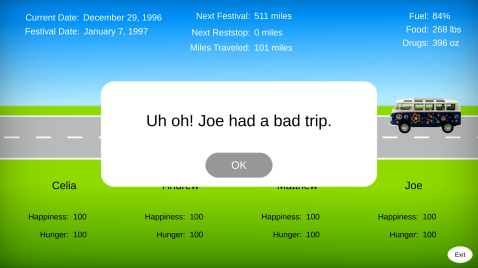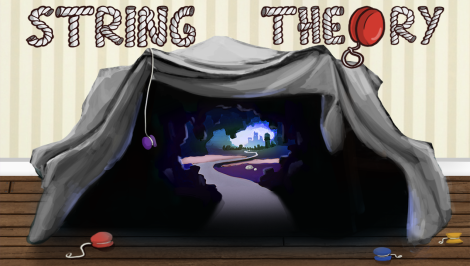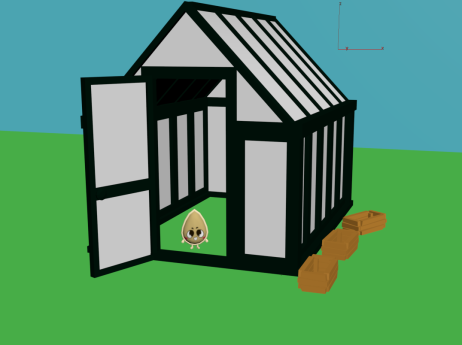As I’ve previously mentioned in past blog posts, this semester I’m taking my third production class, strangely enough called Production II. The yearly production classes we take at Champlain have each of the game disciplines (design, programming, art, and production) working in team settings to create games. In our first year, it was really about learning the process of making games. Last year, we came back to producing games after having honed our skills on our own, and we got to experiment on projects with different goals and meet people in order to familiarize ourselves with the other students.
This year, however, we’re starting to get serious. We’ve formed teams where we produce three prototypes of any games we choose to create in three weeks, and then we will choose one to pursue that we will polish up and present. After presentations, the professors (acting as studio heads) will discuss with us what games should be cut and what games should move ahead to be completed over the course of the rest of the semester. This is to simulate the process most AAA studios go through.
My team, Doceratops Studios, is comprised of:
- myself as the lead designer and associate programmer
- Andrew Rimpici, lead programmer and the programmer I worked with on every project last year during our production course
- Michelle Lee, our very talented lead artist who specializes in environment art
- Brett Schwartz, our lead producer who I’ve had the pleasure of knowing for 7 years and easily the best producer I’ve ever worked with
So why don’t we just get into the games, shall we?
Sprint 1 – Hippie Road Trip

Hippie Road Trip came about as an idea gone awry from the phrase “rest stop” during a brainstorming session. What started out as a normal highway driving game turned into an Oregon Trail-esque resource management game where players lead a van full of hippies through the summer festival circuit, maintaining good vibes and stocked resources while adapting to the random events that happen along the way. The intent of the game was to create a relaxing and goofy game where different players experience different stories based on the random events they encounter, and we found that the hippie culture was untapped for its creativity and market.
For the design of the game, I used the obvious inspirations of Oregon Trail and Organ Trail, along with other random event-based games like The Yawhg, but twisted it to feel much more about a group of friends enjoying the things they love rather than struggling to get by. Resources would be spent to keep the group happy and going, not clawing their way to the next pit stop for food. Brett enjoys hippie culture quite a bit, and he was able to help us make the game as close to his experiences of attending Phish concerts as possible.
Sprint 2 – String Theory

String Theory was a game I came into this class wanting to make, but I never could’ve expected what we’d end up with. Every time I told someone the concept of “VR yoyo combat”, I was met with positive reactions, so after pushing my team to get out of their comfort zone and take a chance on both VR and this crazy idea, I knew we had to deliver. The game involves a group of children playing make believe that they are in a secret underground city. The player takes on the role of a yoyo-wielding explorer who must use their yoyo to defeat enemies, explore the mysterious city, and solve light puzzles.
With such a unique idea, I had a lot to go off of in terms of how to design the game. We really wanted to make most of the interactions motion based with the VR controllers, and we knew that making the yoyo feel good was our key to success. We drafted up a ton of ideas for combat moves and encounters that we’re holding, but our goal for the prototype was to get to yoyoing and the attacking in. The gameplay loop would roughly follow that of Resident Evil games, where players explore areas and defeat enemies along the way as they search for the way forward. None of us had worked in VR before, so we had to learn a lot in addition to creating a decently-complex system.
Sprint 3 – Plant Parenthood

Riding off of the high of the positive first two weeks and our newfound appreciation for VR, we decided to play it a bit simpler for week 3. Plant Parenthood was what came of many discussions of our love for simpler pet simulators like Nintendogs, Tamagotchi, and Neko Atsume, where our hope was to create a game as cute as the inspirations, but with pet interaction in VR. Our nondescript pets turned into plant creatures, and Plant Parenthood was born. The game tasks the player with caring for and raising various plants in order to grow them to produce products that can be sold at the farmer’s market for more plants, furniture, and toys.
We didn’t simply want to convert raising a normal creature into VR, because we’d already seen the potential that Neko Atsume VR had capitalized on. Instead, we wanted to create a larger cast of unique creatures, and putting them as plants grounded the idea (no pun intended) into something we could play off of. Instead of bathing your creature, you’d water it. Instead of feeding it treats, you’d feed it nutrients. We didn’t want to overcomplicate the idea too much, but we also couldn’t stand to just create an exact copy of something we already loved.
After all three projects were said and done, we knew that, based on our interests and the feedback we’d received, we were going to move forward with String Theory.
The prototype took a lot of work on my part during the first week, because Andrew was having a pretty hard time understanding where I wanted to take the concept, but the end result was something that had both of us, and the class, excited. We managed to get the yoyo physics feeling pretty good, with the player able to throw and catch the yoyo and haptics allowing the player to feel the yoyo. We also figured out how to create UI elements in VR, with an enemy prime for attacking with a glowing health bar above it. The class was blown away by the idea, which was very satisfying given how much trust the team had put in me because of how hard I pushed the game. It wasn’t pretty, but it was still an impressive first step in what we’re hoping to move forward with.
So after we finished up on Plant Parenthood, we immediately moved into planning the sprint. Andrew would build the systems for the yoyo, and I would have to build the level and all of its interactions. A lesson I learned here is that we definitely need a building generator, because placing each wall piece is awful and way too time consuming in Unity! However, after finally getting the level built with Michelle’s models, I was able to focus all of my attention on implementing content. This is the stuff I love to program, just getting my hands into the smallest parts and programming them to work. The three major additions I added were getting buttons to activate various systems around the level, programming the enemy pathfinding and attack systems, and getting enemies to attack the player when the encounter is triggered.
With the project fully put together, I’m extremely impressed with the work we’ve done. Michelle’s art looks awesome and really brings the level to a huge scale when in VR. Andrew’s yoyo mechanics feel incredibly gratifying and solid. There’s a lot of small issues like the general atmosphere of the level and some simplistic interactions, but the prototype really shows just how far we can bring this game in such a short time. I’m incredibly excited to show off the game at midmortems, and I hope people enjoy it!